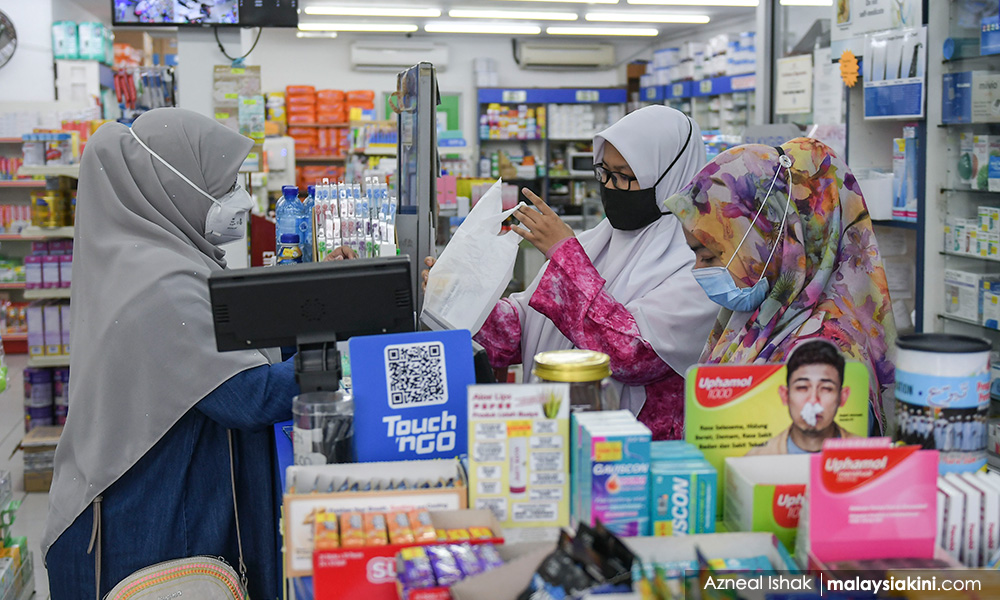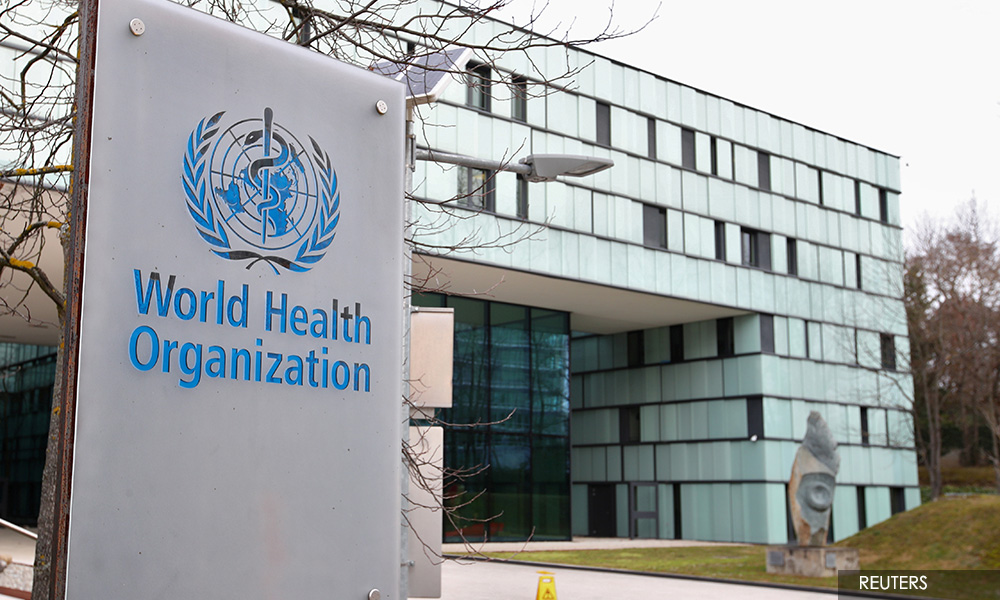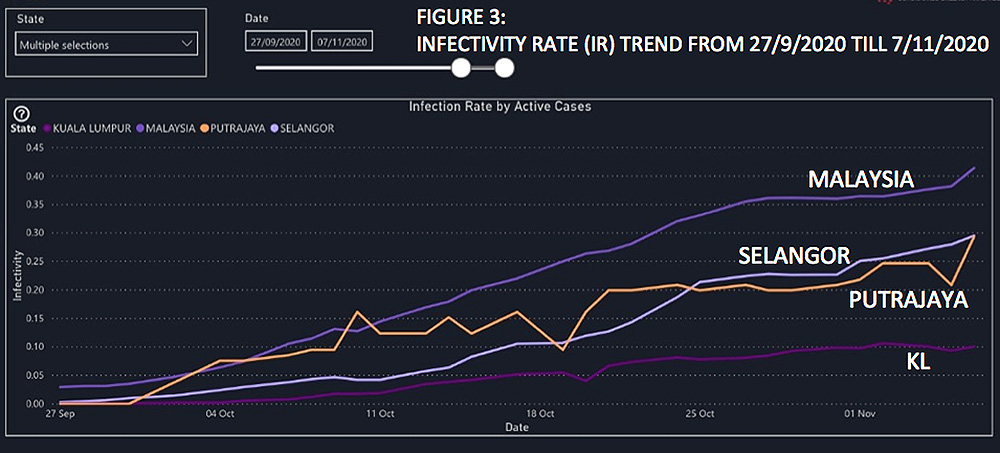LETTER | No MCO, the rakyat and nation are hemorrhaging
LETTER | Since the Health Ministry has embargoed all Covid-19 data, it is virtually impossible to decipher their rationale for extending this next round of conditional movement control order (CMCO) from Nov 9 to Dec 6.
What is the matrix that the National Security Council (NSC) or Health Ministry is using to impose another round of CMCO? We searched high and low for the science mandating an extension of the CMCO but it is not forthcoming from either the NSC or the ministry.
With the assistance from our public health and infectious diseases physician colleagues, we would like to offer data and trends captured from the ministry's statistics in the public domain that makes the CMCO untenable from the perspectives of evidence-based medicine.
Absolute numbers of Covid-19 cases in any one state is not a useful parameter for the sake of comparison between states. It needs to be expressed as a proportion of the state’s population. This is a basic statistical tool for meaningful comparison.
Figure 1 courtesy of Dr Lokman Hakim Sulaiman, illustrates the incidence rate (per 100,000 population) plotted from the epidemiology weeks 40 till 44 (1st week of October until 1st week of November 2020).
Eyeballing the graph, one can immediately summarise that the two problem states which merit the consideration of an MCO are Labuan and Sabah. The incidence rates in KL, Malacca, Sarawak, Pahang, Johor, Perak, Perlis, Terengganu, and Kelantan are virtually negligible in comparison.
Additionally, the upticks in the incidence rate in Putrajaya, Negeri Sembilan, Kedah, Selangor, and Penang can be best managed with a robust Test-Trace-Isolate-Support (TTIS) response without the imposition of a nationwide CMCO.
The various MCOs are inflicting devastating damages on individual, family, community, and national economic activity, severely impacting our daily livelihoods, and driving families and communities to below the poverty line.
Figure 2 represents the latest infectivity rate (IR) that was calculated on 6 November 2020 when the population numbers were taken into account.
The immediate observation is that the IR (in brackets) for the territories in the Klang Valley which are under CMCO: Selangor (0.295), Putrajaya (0.294), and KL (0.101) are well below the national average of 0.414. It is misleading to look at any one point in time (date-specific) to make a comparison of their respective performances. Instead, we should look at the trends of IR to arrive at any valid scientific conclusions.
Figure 3 represents the trend of IRs beginning from Sept 27, just before the start of the CMCO on Oct 14, until yesterday (Nov 7). This reaffirms that the IR trend for all three territories in the Klang Valley are well below the national average.
If anything, the IR trend for KL, the hub of the nation’s economic activity, is flattening and a continuation of the CMCO does not make any scientific nor economic sense. Even the IR trends in both Selangor and Putrajaya are decelerating compared to the period of Oct 11 to 25, except for a most recent uptick in Putrajaya.
Therefore, it is difficult to comprehend the assertion that "The decision to order a partial lockdown in six peninsular states came about because conditional movement control orders (CMCO) take time to have effect."
Another commonly cited metric is the reproduction number (R0) or it’s sister Rt. Rt is inherently complex, from which no independent review can be made unless the author discloses the many assumptions that have been made.
The complexity of Rt, combined with its tendency to be skewed by the on-the-ground context (for e.g. a new big cluster in a detention centre in District A which is isolated from the community of District A), contributes to the lack of a systematic and daily reporting by the Health Ministry of the Rt figure for each state.
This sporadic and inconsistent manner of Rt reporting compels us to question the reliability of the ministry's use of the Rt as a metric to determine the start or end of an MCO.

To muddy the situation further, in an earlier article, we discussed the limitations of the R0 within the context of the new science of the super-spreader phenomenon and the more exact value and usefulness of the new variable, the dispersion factor “k”.
Notwithstanding, in the earlier mentioned media report, the ministry stated that “If we look at the start of the third wave, the infection rate (R0) was at 2.2 but in two weeks we have brought it down from 1.5 to 1.0.”
From Lokman's incidence rate, and our infectivity rate figures, the infection rate has somewhat plateaued in KL and is decelerating and improving in both Selangor and Putrajaya. And if we are to accept at face value the ministry's R0 figures, the transmission rate has been decreasing to 1.0.
The sensible and scientific decision would be to lift the CMCO, not to prolong it further. As we alluded in our earlier article, the endgame of any degree of physical distancing, in our case the CMCO, is to quickly suppress the total positive cases, reduce fatality rates, and provide immediate relief to the healthcare system.
It is to allow the infected, isolated, and quarantined healthcare workers to stay alive, get better, and get back to work. It buys precious time so that the healthcare capacity is protected and not overwhelmed.

All the data currently at our disposal suggest that the ministry was on top of the Covid-19 situation in the peninsula and that healthcare facilities were neither threatened nor overwhelmed.
At no point in time was the healthcare capacity in the peninsula challenged nor compromised unlike the criticality of the healthcare facilities in Sabah. These scientific rationales among others debunk the need for any form or any further continuation of the CMCO.
But the critical proviso is that the built-in TTIS rapid response must be functional and robust.
For surveillance purposes, we strongly recommend the mass utilisation of the Rapid Test Kit-Antigen (RTK-Ag) instead of the Rapid Test Kit-Polymerase Chain Reaction (RTK-PCR) because of its rapid turnaround time, simplicity of use, and low cost.
The World Health Organisation (WHO) and its partners are making the RTK-Ag available at USD5 (RM20) per kit to all low- and middle-income countries including Malaysia. This is at least 15 times cheaper than the RTK-PCR. This is definitely the test of choice given its accuracy and the difficult economic times we are going through.

We appeal to the NSC to make this test available in both the public and private health sectors at an affordable price so that now everyone can test.
The Health Ministry should benchmark itself against the best in the management of Covid-19. The following indicators would determine whether our TTIS process is robust enough:
- What percentage of tests are done and results returned within 24 hours?
- What percentage of cases with a positive result is successfully contacted within 24 hours to trace their contacts?
- What percentage of positive cases share their close contacts with the contact tracers?
- What percentage of named contacts are tracked within 24 hours?
- What percentage of contacts comply with isolation?
- And, if someone with symptoms has a negative result and symptoms persist, how quickly do they receive another test?
It is very critical to emphasise that Malaysia’s Covid-19 strategy must be informed by and adapted to the local context, with the use of evidence-based measures, not blunt outbreak tools. The CMCO is like a blunt scalpel and any surgeon would know that a blunt scalpel cannot excise cancer but would instead inflict unnecessary and collateral damage to the surrounding tissues.
Thus CMCO alone, without large-scale data-driven testing to detect cases early, swift contact tracing, and isolation would not be sufficient to contain Covid-19.
Given the negative repercussions of lockdowns, we must always be ahead of the curve and utilise the right outbreak tools – evidence-based and data-driven – and not rely solely on blunt scalpels. The rakyat and the economy are haemorrhaging.
The views expressed here are those of the author/contributor and do not necessarily represent the views of Malaysiakini.
RM12.50 / month
- Unlimited access to award-winning journalism
- Comment and share your opinions on all our articles
- Gift interesting stories to your friends
- Tax deductable



